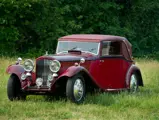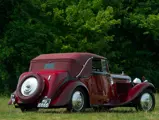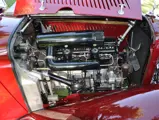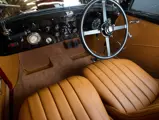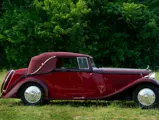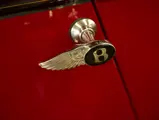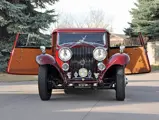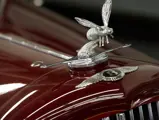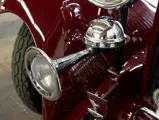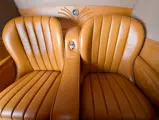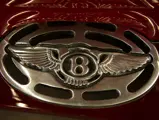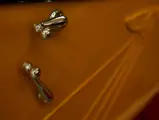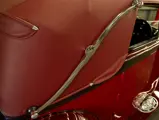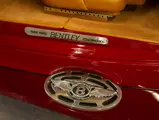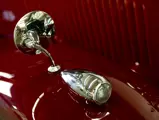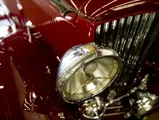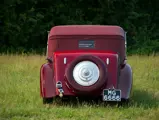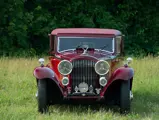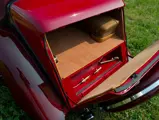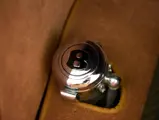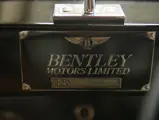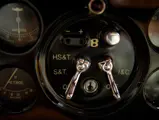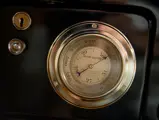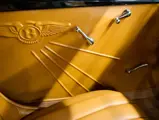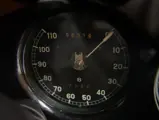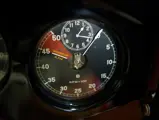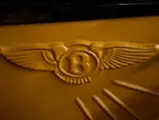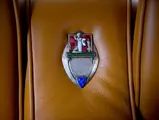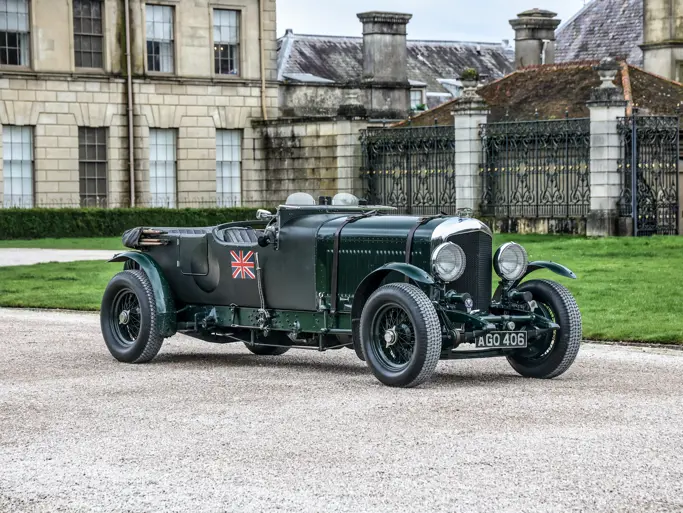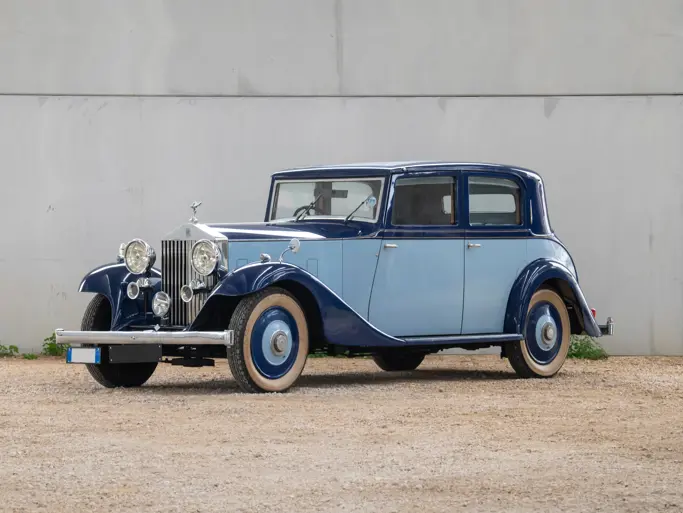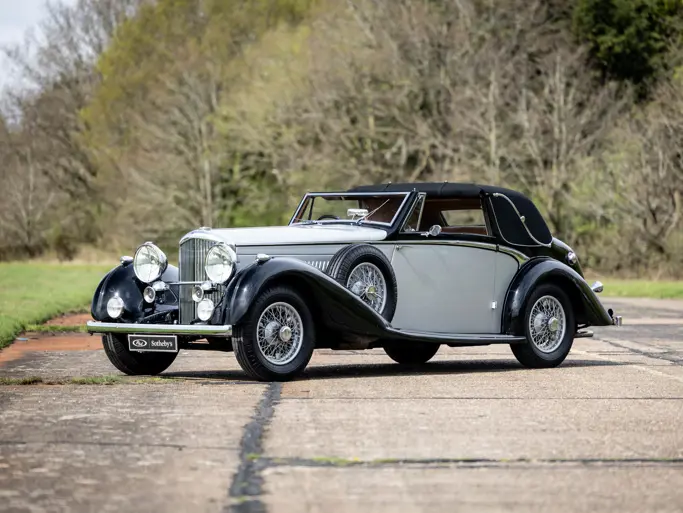Monterey 2011
1934 Bentley 3 1/2-Litre Drophead Coupe by Park Ward
{{lr.item.text}}
$250,000 - $350,000 USD | Not Sold
 | Monterey, California
| Monterey, California
{{internetCurrentBid}}
{{internetTimeLeft}}

115 hp, 3½-liter, OHV six-cylinder engine, four-speed manual synchromesh transmission, front and rear semi-elliptic leaf springs, rear live axle, four-wheel, vacuum-assisted mechanical drum brakes. Wheelbase: 126"
- Period-correct Park Ward DHC body
- Matching-numbers car with original tools, license plates and manuals
- Fitted with period-correct Park Ward DHC body
- Five original Rudge-Whitworth wheels
- $400,000 restoration completed in 2009
- Photo-documentation of restoration with 160 images
The Bentleys produced in tandem with Rolls-Royce in the 1930s are commonly referred to as “Derbys,” since they were built in the shared Rolls-Royce and Bentley Motors Works in Derbyshire, England. The 3½-Litre Bentley was introduced to the public at Ascot Race Course in August 1933. Powered by a larger and sportier version of the small Rolls-Royce 20/25 engine, it was well-received by the press and public alike, and 1,191 were sold between 1933 and 1937, overlapping the 4¼-Litre Bentley, which replaced it.
Rolls-Royce had acquired Bentley Motors in 1931 in a hand-shake agreement with W.O. Bentley, promising to continue to produce cars with the Bentley badge. Promising to do so was one thing, but actually doing it was another. The company struggled for two years to design and produce an appropriate car that would respect the “W.O. Bentley” sporting and racing heritage rather than the more stately cars carrying the Rolls-Royce badge. The early 1930s were challenging times financially, and Rolls-Royce approached the new Bentley model prudently, carefully managing production costs, while creating an exciting car to attract new car buyers.
To limit re-tooling costs, the Bentley 3½-Litre was based on the Rolls-Royce 20/25 hp chassis. The new Bentley engine was re-configured from the 20/25’s 2¾-liter motor by increasing displacement, adding a new cross-flow head, twin SU carburetors, higher compression ratio and a re-profiled camshaft. The result was a fast, smooth, long-lasting, responsive and excellent-handling car that was marketed as “The Silent Sports Car.” The Derby Bentley rapidly became the favored car for the boy- and girl-racers of the day.
In recent years the Derby Bentley has come into great favor with collectors world wide, not just British car enthusiasts. Few prewar cars carry more graceful coachwork, nor offer more fun behind the wheel, than the Derby Bentleys of the 1930s.
Bentley enthusiasts have always recognized that the quality of the car is on par with everything else Rolls-Royce has produced, yet the 3½-Litre Bentley also provides brisk acceleration and responsive handling, and with a top speed of over 90 mph, its low-revving engine can cruise all day at freeway speeds. It is deservedly one of the most popular tour cars in club events. The cars are ideal for the serious enthusiast who loves to drive, especially the models fitted with early lightweight coachwork, like this example.
The car on offer, B203AE, was originally sold to G. Fitzherbert Wright, by University Motors of London on March 26, 1934. Copies of original documents accompany the car and include specific equipment and dynamometer test results. The invoice for the chassis was £955, and the car was fitted with a Hooper four-door saloon body. The same documentation indicates the owner anticipated using the car for “in town” transportation as well as continental touring.
B203AE later belonged to Captain Percival Kent of Sherborne St. John in Hampshire. A letter accompanies the car from his neighbor A.D. Carter, who remembers that the eccentric owner only drove the car two weeks a year – at Christmas. In intervening years, the handsome Bentley made its way to the United States and was discovered by West Coast Bentley enthusiast Gary Wales, who is well known and respected for his attention to detail in restoration projects. When Mr. Wales acquired the car, the body was off the chassis, which required restoration. However, the chassis and engine were complete and original, with verified matching numbers.
Mr. Wales had the good fortune to find an original Park Ward drophead coupe body, which had been removed from its original chassis B32EJ. Wales’s painstaking subsequent full mechanical and cosmetic restoration of B203AE exceeded $400,000 – an extraordinary sum. Accompanying the car are 160 detailed photographs of the restoration, which was completed in 2009 with no expense spared. The car is tastefully presented in burgundy with maroon fenders, a central spotlight, rear-mounted spare and fitted luggage – an elegant yet very sporting appearance.
The “flying bee” mascot, a rare Lejeune piece, was installed by Wales as it was known that Captain Kent, according to A.D. Carter, was a beekeeper. The insulated Blackwood Burgundy top features a luxurious Wilton headliner, which would need to be modified to enable the top to be lowered if open-air driving is desired. Although it is not confirmed, the hardware for the operational top is believed to be in place.
Despite the correct period replacement body, B203AE is by no means built up from other Bentley components. Simply put, it is an original 1934 Bentley chassis with an original 1935 Park Ward drophead coupe body. It will be delivered to the new owner complete with documentation validating it to be a matching-numbers car with its original engine. The car comes complete with the original fitted hand tool tray, road tools, owner’s manual and its original British registration plates, MG 6666. For Derby Bentley enthusiasts, this is a very important factor. Even more remarkable, this car retains its original factory-specified “knock-off” racing wheels. Even the under-seat tool kit is substantially complete.
From 1933 through 1936, 1,177 Bentley 3½-Litre cars were produced in 12 VIN number series. About half of those, or 529, were bodied by Park Ward. This car is one of the earliest produced and is part of the first VIN Series “AE.” Such cars are in great demand by Bentley enthusiasts and astute collectors of all marques. Moreover, they afford the new owner a lovely entry for participation in events organized by the Rolls-Royce Owners’ Club, the Bentley Drivers’ Club, the Rolls-Royce Enthusiasts’ Club and even the Classic Car Club of America.

